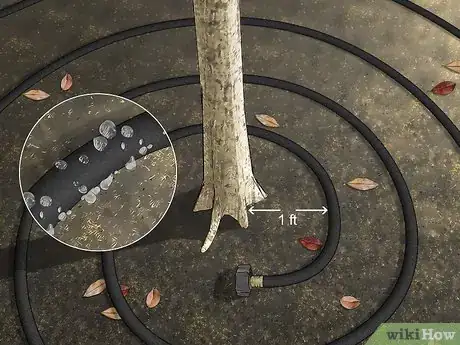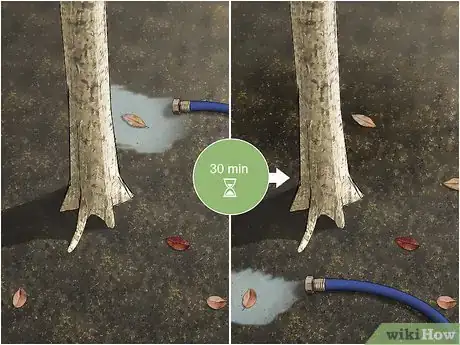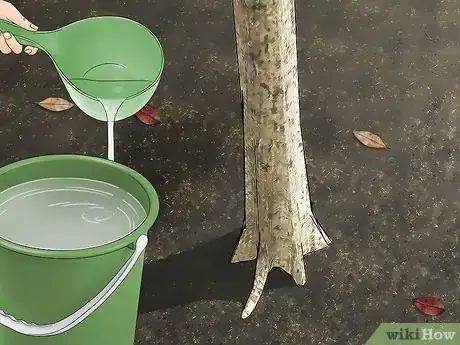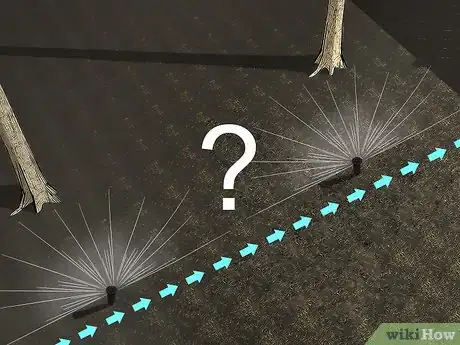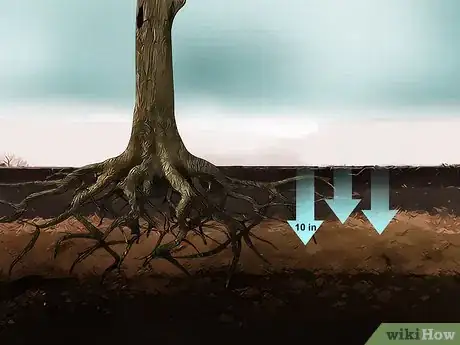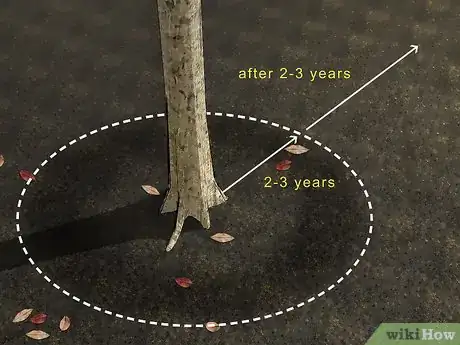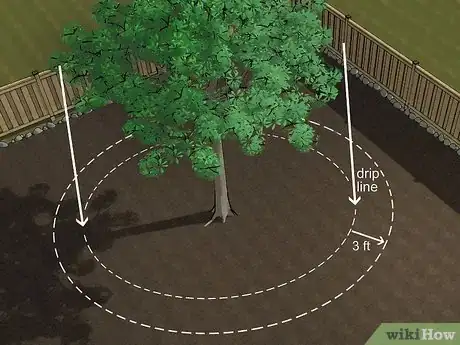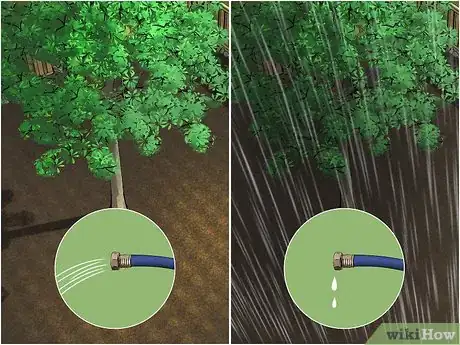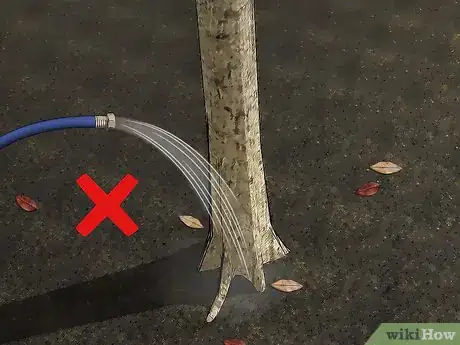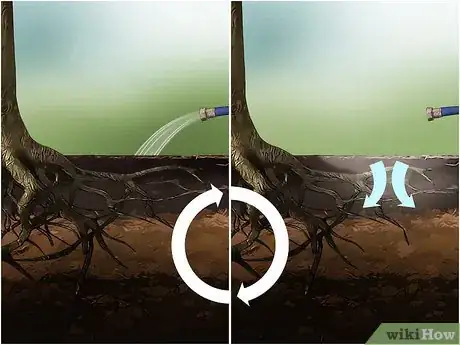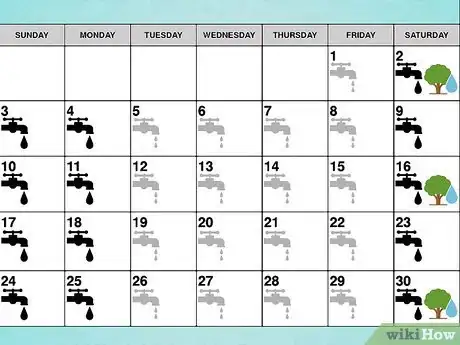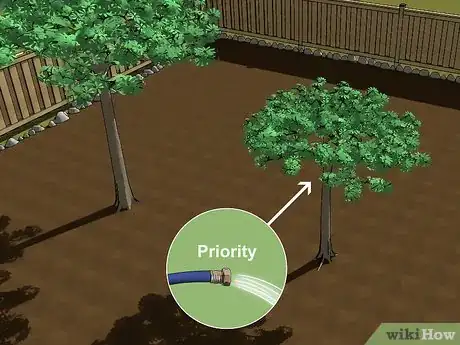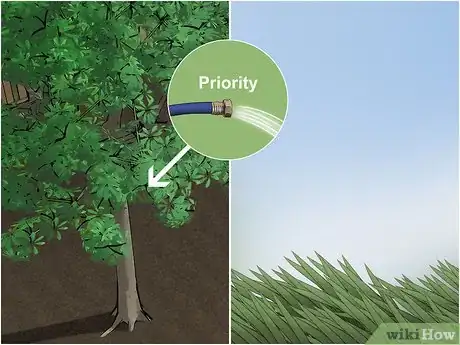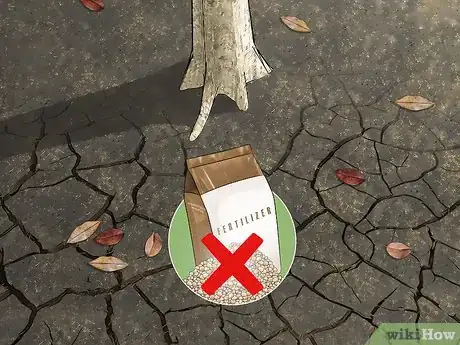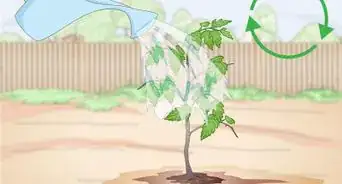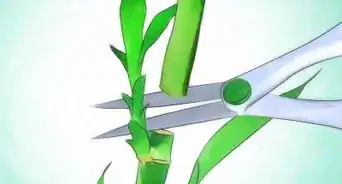This article was co-authored by Lauren Kurtz. Lauren Kurtz is a Naturalist and Horticultural Specialist. Lauren has worked for Aurora, Colorado managing the Water-Wise Garden at Aurora Municipal Center for the Water Conservation Department. She earned a BA in Environmental and Sustainability Studies from Western Michigan University in 2014.
This article has been viewed 43,148 times.
Trees are a great addition to any yard. They can last for decades when properly cared for, and they will reward you with ample shade. Depending on the type of tree, you may even get flowers or fruit! Knowing how to water your tree properly is important. Each species of tree will have different watering needs, but the basic techniques will be more or less the same.
Steps
Choosing the Right Tool
-
1Use a soaker hose for best results. Wrap the hose in a spiral around the tree, starting outside the canopy's perimeter and finishing 12 inches (30 cm) from the trunk. Turn the hose on, and let the water soak into the soil. Keep running the water until the top 10 inches (25 cm) of soil are moist. This can take a few hours depending on the size of the tree and how dry the soil is.[1]
- A soaker hose is a porous hose that slowly releases water over a period of time.
-
2Try a regular hose if you want something that is quick and easy. Place a hose on the ground next to the trunk and turn it on. Every 30 minutes, pick the hose up and move it to another spot around the trunk. Do this for a total of 1 to 2 hours, or until the tree is fully watered.[2]
- You may have to adjust the water pressure on the hose so that it comes out in a slow trickle rather than a forceful gush.
Advertisement -
3Switch to a bucket if you can't reach the tree with a hose. Fill a large bucket with water and carry it over to the tree. Pour the water onto the soil around the tree. Keep making trips until the soil is fully watered. You will need at least 10 gallons (37.8 L) for a young tree--more for an older one.[3]
- If you have a lot of trees to water, consider loading multiple buckets onto a wagon, then pulling the wagon over to the trees.
-
4Use overhead sprinklers as a last resort. These are a good way to cover large areas, but they don't provide a lot of moisture, and the moisture they do provide gets lost to evaporation. You should only use overhead sprinklers if you live in a cool area that doesn't receive a lot of sunlight.[4]
- If you must use a sprinkler, keep the water low so that it focuses on the ground rather than the leaves.[5]
-
5Don't rely on your lawn's irrigation system. Many lawns have irrigation systems, which are great for things like flowers and grass. This is not enough for a tree, however. Trees need a deep, soaking every 1 to 2 weeks rather than a shallow sprinkling every few days.[6]
Providing Adequate Moisture
-
1Research how much water your tree needs. Different types of trees will need different amounts of water, so it's important that you get off to a good start. If your tree did not come with a care tag, research the tree's species online. You can also look at books in the library, ask an arborist, or visit your local nursery.[7]
- Some trees will require more water, such as the red or silver maple, or the paper or river birch.
- Other trees will require less water, such as the Arizona cypress, Japanese Zelkova, the white fir, or the Kentucky Coffeetree.
-
2Water the soil to a depth of 10 inches (25 cm). Most of roots are going to be concentrated within the first 10 inches (25 cm) or so of soil. Watering the soil to a depth of 10 inches (25 cm) will ensure that these roots get enough water. You can tell if you've watered deep enough if you dig down 10 inches (25 cm) and the soil is still wet.[8]
- When the first 6 inches (15 cm) of soil are dry, it is time to water again. Test the soil by driving a screwdriver into it. The screwdriver will come out damp and dirty.
-
3Keep newly-planted trees evenly moist for the first 2 to 3 years. Focus on the root ball for the first few months. After that, you can expand your watering towards the perimeter of the canopy. After 2 to 3 years, the tree will become established, and you can reduce the watering.[9]
- Water your tree at least once per week. During hot, dry seasons, water the tree 3 times per week.
-
4Water 3 feet (0.91 m) outside the drip line for established trees. Watering a tree within the drip line is a good rule of thumb, but once a tree becomes established, its roots may extend beyond the drip line. Plan on watering about 3 feet (0.91 m) beyond the drip line to ensure that the roots are evenly soaked.[10]
- The drip line is the perimeter of the canopy.
-
5Take the environment and season into consideration when watering. Despite your tree's age, there are times when you will need to water your tree more or less often. For example, young trees need to be watered every 1 to 2 weeks. If you are entering a wet season, however, you won't need to water your tree as much due to all the rain. On the other hand, you will need to water your tree more often during hot and dry seasons. Other things to consider include:[11]
- Root and tree health: a sick tree or a tree with damaged roots will need more water to recover.
- Soil type: More-porous soil will need more water than less-porous soil. If your soil contains lots of sand, be prepared to water often, and vice-versa for clay-based soil.
- Tree species: drought-tolerant trees don't need much water while moisture-loving trees do. Research your tree to find out exactly how much water it needs.
- Remember that watering too much can harm your tree.
Watering Efficiently and Safely
-
1Do not water around the trunk. If you water around the trunk, you risk the soil and trunk rotting, which can kill your tree. You should water 10 to 12 inches (25 to 30 cm) away from the trunk of the tree. This is especially important for established trees.[12]
- You should water young trees near the trunk. Once the tree becomes established, you can water further away from the tree.
-
2Water in short bursts and give the water time to soak in. It is best to water the tree in short bursts rather than all at once. When you water the tree, allow the water to run until it starts to pool, then turn the water off and let it soak into the soil. Repeat this watering and soaking process until the first 10 inches (25 cm) of soil are moist.[13]
- Watering in short bursts will allow more oxygen to reach your tree.
-
3Avoid watering the tree during the hottest part of the day. This will vary depending on where you live, but in general, it is anywhere between 10am and 6pm. If you water your tree during this time, you risk losing the water to evaporation. Instead, water the tree before 10am or after 6pm.[14]
-
4Apply 2 to 3 inches (5.1 to 7.6 cm) of mulch to help conserve water. This will not only keep water from evaporating, but it will also prevent grass from growing around the tree and using up all the water. Apply a 2 to 3 in (5.1 to 7.6 cm) layer of mulch in a 3 ft (0.91 m) wide ring around your tree.[15]
- You don't need to do this every time you water the tree--just the first time you plant the tree.
- Don't pile it against the trunk or you may get rot. If the mulch starts to rot, replace it.
- Organic mulch, such as pine straw or shredded bark, works the best.
Watering During Droughts
-
1Plan your watering according to the water restrictions. Different cities will have different restrictions. Some cities will only allow you to water gardens on certain days, while other cities will have no restrictions on trees. If you have no restrictions, water your trees as usual. If you do have restrictions, water your trees whenever you can.[16]
-
2Focus on younger trees if you have multiple trees on your lot. Older trees can survive on a deep watering once a month during a drought, although twice a month would be better. Young trees are much more delicate, however, and should be watered at least once per week. Once the drought is over, gradually reduce how often you water your tree until you are watering every other week.[17]
- Water older trees to a depth of 8 to 12 inches (20 to 30 cm) once or twice a month during a drought.
- Water younger trees at least once per week with 5 to 15 gallons (18.9 to 56.8 L) of water during a drought.
-
3Choose trees over annuals and grass during a drought. Grass is cheap and easy to replace, and annual plants will die by the end of the year anyway. A tree will be much harder and more expensive to replace. When you have a water restriction, you should use whatever water you have on your tree.[18]
- Don't abandon your lawn entirely. Water it from time to time, even if it looks dead. This way, the grass will be able to regenerate once the restrictions are lifted.
-
4Do not fertilize your tree during a drought. Instead, focus on watering the tree. If you fertilize your tree, you will cause it to enter a growth spurt--which means that the tree will need even more water. It is best to leave your tree stunted during a drought. It will be smaller, but it won't need as much water.[19]
- Many fertilizers contain salts, which can harm the roots during a drought.
- Do not use lawn fertilizers high in nitrogen.
- Don't use weed-and-feed products either. They are a fertilizer/weed-killer combo.
Community Q&A
-
QuestionWhat's the best way to water established Aspen trees?
 NinoxTop AnswererIf the Aspen trees don't get enough water, you can dig moats to irrigate the ground.
NinoxTop AnswererIf the Aspen trees don't get enough water, you can dig moats to irrigate the ground. -
QuestionI have two Chinese Chestnuts planted this spring. How much do I water them?
 NinoxTop AnswererWater the tree only when the soil is completely dry. When you water them, make sure that the dirt is wet but not soaked.
NinoxTop AnswererWater the tree only when the soil is completely dry. When you water them, make sure that the dirt is wet but not soaked.
Things You'll Need
- Trees
- Water
- Mulch
- Soaker hose or regular hose
- Bucket
- Screwdriver
References
- ↑ https://www.gardeners.com/how-to/when-to-water-trees/7931.html
- ↑ https://www.loveyourlandscape.org/expert-advice/tree-care/soil-and-root-care/the-correct-way-to-water-your-trees/
- ↑ https://www.loveyourlandscape.org/expert-advice/tree-care/soil-and-root-care/the-correct-way-to-water-your-trees/
- ↑ https://www.gardeners.com/how-to/when-to-water-trees/7931.html
- ↑ https://www.loveyourlandscape.org/expert-advice/tree-care/soil-and-root-care/the-correct-way-to-water-your-trees/
- ↑ https://www.gardeners.com/how-to/when-to-water-trees/7931.html
- ↑ https://www.arborday.org/trees/tips/watering.cfm
- ↑ https://www.gardeners.com/how-to/when-to-water-trees/7931.html
- ↑ https://www.gardeners.com/how-to/when-to-water-trees/7931.html
- ↑ https://www.gardeners.com/how-to/when-to-water-trees/7931.html
- ↑ http://www.phytosphere.com/vtf/treewater.htm
- ↑ https://www.gardeners.com/how-to/when-to-water-trees/7931.html
- ↑ http://www.phytosphere.com/vtf/treewater.htm
- ↑ https://www.gardeners.com/how-to/when-to-water-trees/7931.html
- ↑ https://www.gardeners.com/how-to/when-to-water-trees/7931.html
- ↑ http://blog.davey.com/2016/08/how-often-to-water-trees-during-a-drought/
- ↑ http://blog.davey.com/2016/08/how-often-to-water-trees-during-a-drought/
- ↑ http://blog.davey.com/2016/08/how-often-to-water-trees-during-a-drought/
- ↑ https://www.gardeners.com/how-to/when-to-water-trees/7931.html
- ↑ http://www.phytosphere.com/vtf/treewater.htm
